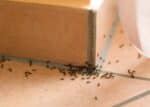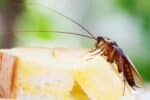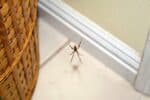
Insects & Lights, What Is the Attraction?
Have you ever wondered why certain insects are attracted to light, while other insects are repelled by light? Have you ever asked yourself what’s so interesting about your porch light, that moths, beetles, and stinkbugs just can’t get enough of it or why cockroaches scatter like “We’re busted, run!” when suddenly flooded by your kitchen light?
Phototaxis
Though no one really knows why . . . several theories exist as to why some nocturnal flying insects are drawn to artificial light. One logical reason can be explained by phototaxis. A common behavior in many species, including insects and fish; phototaxis concerns survival and common logic. You can do things in the light that you can’t do in the dark. The light offers better chances of finding food and avoiding predators, increasing your survival chances.
Transverse orientation
Other entomologists point to a behavior known as “transverse orientation,” theorizing, as UC Berkley entomologist, Jerry Powell does, that somewhere in the internal navigation system of moths and other flying insects, these guys “navigate by flying at a constant angle to a distant light source,” such as the sun, the moon, and the stars. Because moths developed long before the invention of artificial light, in this theory, when insects see your porch light, candle flames or campfires, they become confused as the angle of navigation changes as they fly past the light. So, they continue to fly towards the artificial light source in effort after effort to correct their navigational compasses. Critics of the transverse orientation theory point to the fact that, while electric lighting is a relative newcomer in the evolutionary scale of things, humans have been building fires for nearly 400,000 years. Critics argue moths, after all this time, would be extinct due to an uncontrollable urge to jump in a fire for no specific reason. Also, given the fact that not all moths migrate, especially the tiny ones dazzled by your porch light, they would need no reason for advanced navigation tools.
Pheromone mimicking
Taking a completely different approach to the question, “Why are bugs attracted to light?” in the 1970s, US Department of Agriculture entomologist, Phillip Callahan found a connection between the infrared light spectrum of a candle’s flame and female moth pheromones. Callahan discovered that a few of the frequencies emitted by female moths’ pheromones are slightly luminescent; that is, they faintly glow. Callahan conjectured that male moths, mistaking candle flames for frisky female moths sacrifice themselves for love, flying into the candle’s flame thinking it’s a female mating signal. However, this theory is not without controversy, either, as Powell noted that insects are much more attracted to UV light than infrared light, adding that “there’s no reason why UV light should remind moths of sex; it doesn’t contain the same wavelengths as their glowing pheromones.”
To the moon
In yet another theory, scientists discovered that moths were less attracted to artificial lights during the full moon week than during the new moon week. Urban myth had it that moths weren’t as active around porch lights and such during the full moon because they were all “flying to the moon.” Powell rejected this theory, saying, “That’s ridiculous, because they can’t carry on their life cycles if they’re flying to the moon.” As it turns out, during full moons, moths aren’t as active because there’s too much light when the moon is bright.
Just call Hulett!
Yellow lighting has been shown to deter moths on front porches. When it comes to household pests that are just annoying and those that pose threats to your home and loved ones, Hulett Environmental Services is your go-to locally-owned and operated professional pest control service for the greater South Florida area. Ranked as one of the top 20 pest control companies in the country, Hulett’s over 45 years in South Florida give them the skill and insights you need to pest-proof your home. Our Healthy Home programs use environmentally responsible methods and the latest technology and materials to guarantee you will be satisfied with our services. With convenient options for your busy schedule, contact us to schedule a free pest inspection today. Just call Hulett!



